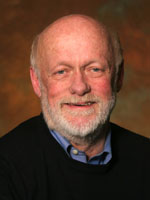
Palmer Taylor
University of California at San Diego
From Materia Medica to Molecules
The first Molecular Pharmacology Gordon Conference was held in 1969, a time when receptors were known to exist only by inference from the selectivity of drug action, but no receptor had yet been chemically characterized. Moreover, little was known about the molecular basis of drug action, and in many cases one could not discern whether the target of drug action was a discrete receptor, ion channel, regulatory protein, particular DNA sequence, or some less selective site in membrane lipids or subcellular organelles involved in DNA replication, protein synthesis, and processing.
Receptors, or “receptive substances,” were proposed by Paul Ehrlich and John Newport Langley around the turn of the last century; yet for seventy years receptors were defined by properties of function and recognition, leaving their chemical characterizations unresolved. In fact, the description of receptors as discrete chemical entities is arguably the cornerstone discovery of molecular phar-macology, and the emergence of molecular-based ap-proaches coincided with seminal discoveries regarding receptor molecules.
In the late 1960s and early 1970s three developments contributed substantially to the discipline of molecular pharmacology. First, Avram Goldstein recognized the importance of communicating molecular-based research in the field of pharmacology and started the journal
Molecular Pharmacology. Second, Arnold Burgen developed a Medical Research Council Unit in Cambridge, England, directed solely toward research on the molecular basis
of drug action. And third, the first Gordon Conference devoted to this subject was developed. Each event contributed in different ways to the generation and dissemination of the molecular foundations of drug action. A look at the early conference chairs, topic organizers, and speakers shows continual participation of members of the Cambridge group and the journal’s editorial board in these conferences.
Looking back at the literature of that period helps us understand how far we have come over the last thirty-five years. Many of the original concepts regarding the targets of drug action might now be thought of as primitive, but without the techniques to purify membrane proteins and characterize targets in low abundance, we had to develop working hypotheses to advance the field. Hence, proposals that acetylcholinesterase was a cholinergic receptor, adenylate cyclase was the beta-adrenergic receptor, and opiate receptors were proteolipids were subjects of papers at that time. These very subjects were debated with much spirit at the early Gordon Conferences. In each two-year cycle of the Molecular Pharmacology meeting one could see more complete characterizations of receptors and other drug targets, new ways to examine conformation of ligands and then soluble proteins that bound pharmacologic agents, and identification of the nucleic acids and lipids that were potential targets of drug action.
As was evident in the early years, advances in the discipline relied heavily on the gifts of nature: rhodopsin as a structural model for G-protein-coupled receptors; the electroplax of fish in the genera
Torpedo and
Electrophorus for obtaining nicotinic receptors and voltage-gated channels; candidate antineoplastic agents that bind to nuclear sites to block cell proliferation; and the peptide and alkaloid toxins that have proven so useful in characterizing drug targets. Such natural probes with a selectivity honed by evolution, when matched with their target identification, have also contributed heavily to understand-ing signaling and structure in modern biology.
Many new technologies have also enabled the field to emerge, such as nuclear magnetic resonance, fluorescence and other forms of spectroscopy, mass spectrometry, and novel affinity methods for purification of resistant proteins. Concepts underlying the recognition and signal transduction properties of drugs could be rigorously tested with these new technologies. Perusal of the list of speakers at early Gordon Conferences shows the continuing involvement of the pioneers in the field, many of whom carried major research endeavors over several decades and up to the current day.
Part of the continuing success of the conference came from participants in several of the sessions who were not aligned to the discipline of pharmacology. They brought novel technologies and systems that widened the research perspectives of the attendees. In turn, the conference brought new applications and research endeavors of therapeutic significance to those outside the pharmacological fields.
Comparing the ontogeny of the modifier
molecular as applied to pharmacology and biology is of interest.
Molecular in pharmacology applies to the working molecules of pharmacology: both the drugs and their structural relationships to neurotransmitters, hormones, and autacoids and the targets of drug action (primarily proteins, but secondarily nucleic acids or lipid sites). By contrast, the
molecular modifier in biology became aligned with recombinant DNA technology. Hence, in the contemporary “-omics” vocabulary, molecular pharmacology has primarily a proteomic and secondarily a genomic base, whereas molecular biology has a primarily genomic base with proteomics being secondary.
Those of us attracted to this emerging field and who attended the early conferences at the New Hampshire sites reserved a portion of the summer for GRC. Between my interest in molecular pharmacology and my wife’s interest in cyclic nucleotides and protein phosphorylation, Gordon Conferences meant traveling to the East Coast, parking our children with their grandparents in upstate New York, and coordinating our vacation time between the New England conference and the family cottage in the Adirondacks. Both were a welcome respite from an in-creasingly urbanized California.